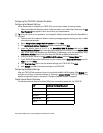
Configuring the TELE3 SP Modem Connection Page 71
Custom Chat Scripts
Custom chat scripts can be used when the ISP dial-up server does not use PAP or CHAP as an
authentication protocol to control access. Instead, the ISP requires a user to log onto the dial-up
server by prompting for a user name and password before establishing the PPP connection. For the
most part, this type of server is part of the legacy systems rooted in the dumb terminal login
architecture. Because these types of servers can prompt for a user name and password in a variety
of ways or require subsequent commands to initiate the PPP connection, a Chat Script field is
provided for you to enter a custom script.
If a custom chat script is required by an ISP for establishing a connection, it is commonly found on
their web site or provided with their dial-up access information. Sometimes the scripts can be found
by using a search engine on the Internet and using the keywords, “chat script ppp Linux <ISP
name>”.
A custom chat script can look like the following script:
ABORT ‘NO CARRIER’
ABORT ‘NO DIALTONE’
ABORT ‘BUSY’
“ ATQ0
“ ATE0
“ ATM1
“ ATW2
“ ATV1
OK ATDT\T
CONNECT “
sername: \L
assword: \P
Tip The first character of username and password are ignored during PPP authentication.
The script looks a lot like the previous script with the exception of the commands at the end. There
is an empty string (“) after Connect which sends a carriage return command to the server. The chat
interpreter then waits for sername: substring. When a response is returned, the current PPP account
user name, substituting the \L command control string, is sent. Then, the chat interpreter waits for
the substring assword:, and sends the password, substituting \P with the PPP account password. If
either the sername or assword substring are not received within the timeout period, the chat
interpreter aborts the dial-up process resulting in a dial-up failure.


















